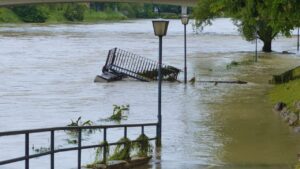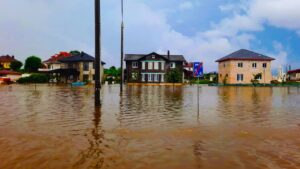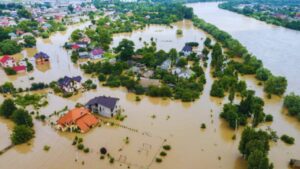Types of Floods

Before delving into the flood causes and effects of floods, it is vital to note that various forms of flooding are seen throughout the sector. Two sorts of flood causes are most common: flash floods and river flooding. This refers to the highest flood tiers viable because of in-depth flooding in low-lying areas. These storms are very risky and are often deadly due to their negative power and splendid speed, which rarely offer human beings the possibility to break out to higher floors or put into effect shielding measures. Flash floods are commonplace in arid lands with company terrains because there is no vegetation or soils to act as defences or barriers in opposition to flooding as a result of heavy rains over land. However, flooding in rivers occurs when a river overflows the financial institution, and water is not limited to the channel. This is more commonplace in areas with wetter weather and lengthy rainy seasons, in addition to near areas where snow and ice thaw. An overflow of water from a lake, river, or ocean into the surrounding land is referred to as a “flood.” Rainfall or snowmelt in huge volumes can result in flooding. In some cases, it is the ground soil that can make the flood causes even worse. This is because rainfall is a natural occurrence. Soil will, in most cases, absorb it like sponges. But if the soil can’t absorb any more water. This will then cause the soil to release more water into a river. It occurs frequently in winter because frozen soil can hardly absorb water. Flooding is a common occurrence after the spring warmth has melted the snow, but before the ground has time to cool. The environmental impacts of flooding and measures to protect against floods are only being addressed in the last few years. From an environmental point view of nature, floods are natural and have the environment with both positive and detrimental consequences. Flood causes and maintains their ecological systems. In the vast majority of important rivers, this natural feedback mechanism has been altered by human intervention, including the development of catchments, the implementation of flood control projects, and more recently, the effects of climate change. In the instant of flooding, destruction can be immediate. Life is lost, property can be destroyed, and crop fields get destroyed when areas in regions in rural areas suffer. Flooding can cause collateral damage. It impacts economic activity as well as a shortage of food. The effects of flooding affect the worth of land. may result in a drop in the value of real estate in regions that are likely to be experiencing flood-related issues. Certain regions have a higher risk of flooding difficulties. Flood Causes in these regions will further aggravate their condition. Floodwater can have serious repercussions that are difficult to address, from ecological destruction to disruption in human lives, its effect makes its management all the more critical.
Here are some strategies to assist you:
- As floodwater levels become more dangerous, timely warning of impending disaster is of increasing importance so people have enough time to protect themselves and their belongings before disaster hits. Flood warning systems provide this invaluable security measure – alerting citizens as early as possible so they have enough time to take appropriate actions before disaster hits.
- For safety’s sake and to reduce damages to property as well as those living within flood-prone zones, buildings constructed above floodwater levels must be constructed to avert flooding-induced losses to both themselves as well as others nearby.
- Water storage system Governments should establish water storage systems to store and reuse excess rainfall, otherwise, it risks overflowing onto plains, leading to flooding. By channeling any surplus towards productive uses rather than leaving flood causes unnecessarily untapped, governments can ensure any surplus will instead contribute towards productive uses rather than overflowing onto flood causes unnecessarily.
- Floods often result from poor drainage systems. to limit accumulations that cause flooding, reliable networks must be built as soon as possible to mitigate flooding risks and protect people living nearby from additional risk factors. Strengthen Your Drainage Network. Poor drainage networks contribute directly to flooding incidents; by building effective networks instead, flooding risks are greatly diminished and prevented altogether.
- It is necessary to erect flood barriers in areas prone to flooding to safeguard residents against further flood accumulations, but once water levels subside, they should be easily removed from these barriers.
What Are the Biggest Effects of Floods?

Nearly two billion people around the world suffered from flood causes between 1998 and 2017. This number is continuing to rise as significant floods become increasingly frequent and more severe. Flash floods, particularly flooding, could destroy entire urban areas and cities. Through time, a lot of people have suffered fatal injuries because of raging floods or other incidents caused by extreme flooding like landslides or collapsed infrastructure. One of the most devastating consequences of flooding is the loss of properties and homes, while important infrastructure and buildings, including hospitals, senior homes, and residences, are destroyed. The loss of power or mobile phone communications is a regular incident during flooding. This may affect the way people live and their security access. The effects of floods could have a massive impact on the economy of a particular region in that extreme weather events affect key sectors and industries such as fishing, agriculture, food, health, labour, and tourism. The results of studies have shown that flooding infrequently could reduce 11% of an area’s gross domestic product by the close of this century. It can take a long time for countries to rebuild their economies following the reduction of natural resources. Residents who reside in areas near rivers or in warmer climates, and especially those who are prone to monsoons, are more prone to flooding. A lot of southeast and south Asian nations, like Bangladesh, which was in the water at some point in the year 2000, as well as India, have been particularly impacted by severe floods recently due to their low-lying landmasses and affluent populace. Therefore, they have experienced massive levels of movement and displacement of populations in the last few years, which has led to an increase in the population density of cities and increased urban poverty. It can lead to longer-term social tensions and inequalities. Flooding has become more likely due to the effects of climate change. According to the 2021 report of Climate Scientists, About Western Europe, downpours in the region that led to flash floods, which claimed the lives of more than 200 people, are now averaging 3–19% more because of human-caused warming. In countries already more susceptible to the rainy season, especially in Asia, the climate models suggest that climate change could lead to greater flooding as well as prolong existing monsoon seasons. A typical monsoon season across Asia will last from June until September. Climate changes may result in the earlier or later departure of monsoons that could disrupt the production of crops and agricultural products, as well as a rise in severe precipitation across the entire region because the release of greenhouse gases increases in the atmosphere.
What Can Be Done in Flood Causes?

One immediate solution would be for governments located in areas prone to flooding to prioritize investments in flood mitigation strategies, which means building more durable infrastructure to withstand water damage and flooding. China stands as an example. They invest heavily in “sponge city” concepts to combat floodwater run-off and recycle rainwater for reuse, as well as helping restore damaged ecosystems simultaneously. Seawall construction provides effective coastal defence measures against surges from storm surges or flooding caused by tropical storms. Managed retreat is the term used for any plan involving the planned migration of individuals or infrastructure away from areas of high flood risk, which should be given serious thought. Floodwaters continue to create forced displacement issues, which affect many economic and social concerns. Managing retreat could reduce stress for affected parties while potentially cutting long-term costs by keeping systems that accommodate migrants in place. But ultimately, the most efficient way of combating climate change and floods lies in decreasing global emissions of greenhouse gases. We must work on decarbonizing transportation systems while making significant investments in green energy sources and technologies such as electric cars. Although many high-income nations, such as the US, have achieved net-zero targets by 2050 with plans to use electric automobiles more widely, most other nations do not possess sufficient funds or speed necessary for effectively combating this climate problem. Deforestation and land use changes often spark debate about their effects on flood risks and severity, yet opinions often diverge on this matter. When analyzing Himalayan deforestation on the Ganges-Brahmaputra Lowlands it was discovered that forests did not protect or significantly decrease flood levels even during extreme weather events such as recent hurricanes in Texas or California, more general research indicates this trend, nonetheless, more general research consistently points out negative deforestation effects while wise land usage and reforestation practices proved positive effects when protecting against flood waters during severe events while deforestation caused damage beyond what forests normally would do so, this dichotomous relationship needs further discordant: deforestation negatively affected flood causes protection while wise land usage practices led to positive flood causes protection benefits while wise land usage/reforestation measures proved positive both. Though rainfall, melting of snow mountains, overflow of water bodies, and hurricanes may be difficult to predict with absolute accuracy, in many instances they can still be predicted, and the government can take measures to prevent waterlogging that leads to flooding. One effective method that has proven highly successful for doing this is employing some or all of the strategies outlined herein.
Top Survival Tips during a UK Storm
]]>It is imperative to stay informed about weather updates and advice from official sources like the Met Office throughout the duration of the storm. Their guidance will provide valuable insights into potential risks such as high tides or areas prone to flooding. Remember that ensuring your safety during a storm goes beyond just physical preparation; staying mentally prepared and calm amidst uncertainty will greatly increase your chances of survival.
Monitor Weather Updates Regularly
One of the most crucial tips for surviving a UK storm is to stay informed and monitor weather updates regularly. Weather conditions during a storm can change rapidly, with high winds, heavy rainfall, and even thunderstorms posing significant risks to your safety. By keeping tabs on the latest weather forecasts and alerts from reliable sources such as the Met Office or local news stations, you can stay one step ahead in preparing for the storm’s impact. Monitoring weather updates not only helps you stay safe but also allows you to plan accordingly. You will have a better idea of when the storm is expected to hit your area, enabling you to take protective measures like securing loose objects or boarding up windows in advance. Additionally, staying informed about weather conditions can help you make decisions on whether it is safe to venture outside or travel during a storm. By being proactive and staying aware of changing weather patterns, you are empowering yourself with knowledge that could potentially save lives during severe storms in the UK.
Trim Trees and Secure Loose Objects

One crucial aspect of UK storm preparedness that often gets overlooked is the importance of trimming trees on your property. During a severe storm, strong winds can easily uproot or break branches, causing them to crash into your home and cause significant damage. By regularly trimming and maintaining trees near your property, you can minimize this risk and ensure the safety of both your family and your home. In addition to tree maintenance, securing loose objects around your property is equally vital during a storm. Strong winds can turn seemingly harmless items like patio furniture or garden tools into dangerous projectiles that can cause serious harm or damage when hurled through the air. Taking the time to secure these loose objects by bringing them indoors or fastening them down not only protects those nearby but also prevents potential damage to neighboring properties.
By being proactive in trimming trees and securing loose objects, you take essential steps toward safeguarding yourself and others during a UK storm. Taking these measures not only helps protect your own property but also demonstrates responsible stewardship towards protecting the wider community from potential hazards.
Stock Up on Essentials
During a UK storm, one of the key tips for survival is to stock up on essential supplies. This includes food, water, and medications. While it may seem like common sense, many people underestimate the importance of having an emergency stash readily available.
Firstly, when it comes to food, it’s important to think beyond just canned goods. Consider items that are easy to prepare without electricity or gas such as freeze-dried meals or energy bars. It’s also wise to have a mix of non-perishable items like dried fruits and nuts in case the power outage lasts longer than expected. Secondly, water is vital for survival during any emergency situation. It’s recommended to store at least one gallon of water per person per day for drinking and sanitation purposes. Additionally, having access to water purification tablets or filters can provide peace of mind in case tap water becomes contaminated due to UK storm damage. Lastly, don’t forget about necessary medications. Make sure you have a sufficient supply of any prescription medications you require as well as over-the-counter essentials like painkillers and cold medicine. Check expiration dates regularly and replace any expired medications promptly. Being prepared with ample supplies of food, water, and medications is crucial for weathering a UK storm successfully. Taking these precautions not only ensures your immediate well-being but also gives you peace of mind knowing that you’re ready for whatever Mother Nature throws your way.
Stay Safe and Be Prepared during UK Storms

Staying safe and being prepared during UK storms is crucial for personal safety and well-being. By following the top 10 survival tips mentioned earlier, individuals can take proactive measures to protect themselves and their loved ones. It is important to keep a close eye on weather updates and use technology such as storm-tracking apps or websites to stay informed about developing situations. Being prepared also means having an emergency kit ready with essential supplies like non-perishable food, water, batteries, and flashlights. It’s wise to secure any loose items in your surroundings that could potentially become hazardous during strong winds or heavy rains. Additionally, knowing how to safely shut off utilities such as gas or electricity in case of emergency can prevent further damage or accidents.
Remember that staying safe during a storm is not just about personal safety but also keeping an eye out for others in your community. Check on neighbors who may need assistance and inform local authorities if you notice anyone in distress. By taking these precautions and maintaining a proactive mindset, we can navigate through UK storms with confidence and ensure the well-being of ourselves and those around us.